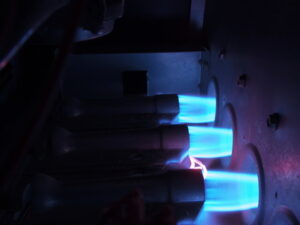 Gas-powered furnaces are not inherently dangerous appliances. That’s something we want to clear up before we go any further. This post is not meant to incite panic—but it is meant to show you the importance that taking care of your furnace has on home safety.
Gas-powered furnaces are not inherently dangerous appliances. That’s something we want to clear up before we go any further. This post is not meant to incite panic—but it is meant to show you the importance that taking care of your furnace has on home safety.
Like any powerful appliance, or any appliance that creates combustion gas, a furnace does have the potential to create health issues if it’s not properly cared for, or if symptoms of malfunctions are ignored. This is particularly true with a gas furnace.
What’s the most common cause for gas furnace hazards? Cracked heat exchangers!
This is most likely to occur in an aging furnace (a heating system 15+ years old). That doesn’t mean you automatically won’t have this problem if you have a newer system, but it’s something to keep in mind. But if your gas furnace is over a decade old, it’s definitely time to assess its potential risks, including a cracked heat exchanger. Read on to learn more about why this is such a big deal.
First, What Is a Heat Exchanger?
This is a vital component within a natural gas-powered furnace: it’s the area where the heat from the combustion gasses transfer to the air from the blower fan before being blown through your ductwork. Combustion gasses are unable to come into direct contact with the air, otherwise unhealthy fumes—namely, carbon monoxide—will end up in your living space.
Rather, the combustion gas enters the heat exchanger, which is a metal, clam-shaped chamber. The heat of the combustion gas raises the temperature of the metal, and as the air from the blower passes around it, heat is transferred into your house. This means the heat exchanger is the component actually responsible for warming your household.
The Problem with a Cracked Heat Exchanger
Since a cracked heat exchanger allows exhaust fumes into your home, it becomes a hazard. The most harmful of these exhaust gasses is carbon monoxide, which can cause serious health issues. The furnace typically sends the fumes out a flue, however a crack can allow some to seep out.
The most likely cause for a crack in the heat exchanger is corrosion. The reaction between the metal of the heat exchanger and the combustion gasses over the years weakens the heat exchanger. This is why it’s something to watch out for in an older furnace, especially. Even the smallest crack can be a big problem since it stretches wider as the heat exchanger turns hot and expands.
If you hear a clicking sound coming from the furnace after the blower shuts off, then you likely have a cracked heat exchanger. You should also call for professional assistance if the CO detectors in your home go off. On that note, if you have any gas-powered appliances in your home, it’s absolutely necessary you have carbon monoxide detectors. If one goes off, turn off your appliances and give the emergency number of your utility line a call to learn about the next steps. Then call us for furnace repair or replacement.
Contact AllTech Services, Inc. for quality furnace repair in Gainesville!

